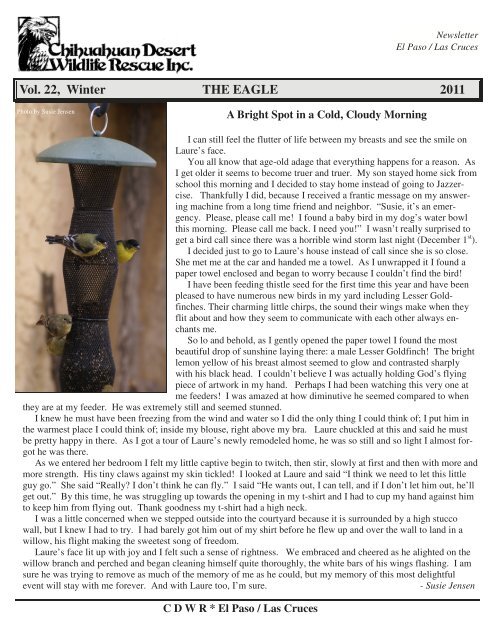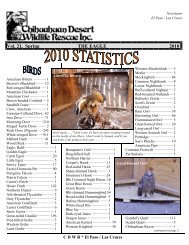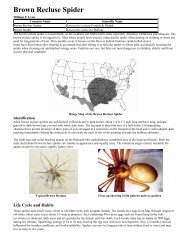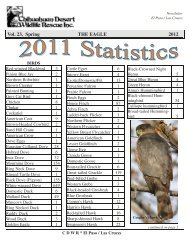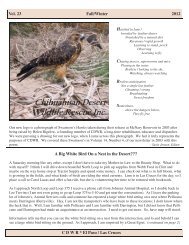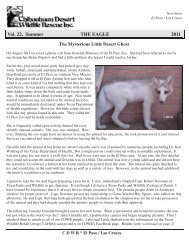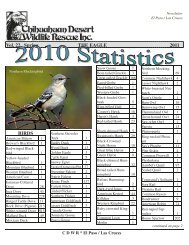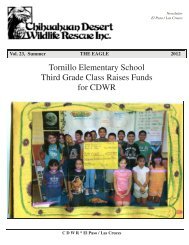Fall/Winter 2011 - Chihuahuan Desert Wildlife Rescue
Fall/Winter 2011 - Chihuahuan Desert Wildlife Rescue
Fall/Winter 2011 - Chihuahuan Desert Wildlife Rescue
You also want an ePaper? Increase the reach of your titles
YUMPU automatically turns print PDFs into web optimized ePapers that Google loves.
Newsletter<br />
El Paso / Las Cruces<br />
Vol. 22, <strong>Winter</strong> THE EAGLE <strong>2011</strong><br />
Photo by Susie Jensen<br />
A Bright Spot in a Cold, Cloudy Morning<br />
I can still feel the flutter of life between my breasts and see the smile on<br />
Laure’s face.<br />
You all know that age-old adage that everything happens for a reason. As<br />
I get older it seems to become truer and truer. My son stayed home sick from<br />
school this morning and I decided to stay home instead of going to Jazzercise.<br />
Thankfully I did, because I received a frantic message on my answering<br />
machine from a long time friend and neighbor. “Susie, it’s an emergency.<br />
Please, please call me! I found a baby bird in my dog’s water bowl<br />
this morning. Please call me back. I need you!” I wasn’t really surprised to<br />
get a bird call since there was a horrible wind storm last night (December 1 st ).<br />
I decided just to go to Laure’s house instead of call since she is so close.<br />
She met me at the car and handed me a towel. As I unwrapped it I found a<br />
paper towel enclosed and began to worry because I couldn’t find the bird!<br />
I have been feeding thistle seed for the first time this year and have been<br />
pleased to have numerous new birds in my yard including Lesser Goldfinches.<br />
Their charming little chirps, the sound their wings make when they<br />
flit about and how they seem to communicate with each other always enchants<br />
me.<br />
So lo and behold, as I gently opened the paper towel I found the most<br />
beautiful drop of sunshine laying there: a male Lesser Goldfinch! The bright<br />
lemon yellow of his breast almost seemed to glow and contrasted sharply<br />
with his black head. I couldn’t believe I was actually holding God’s flying<br />
piece of artwork in my hand. Perhaps I had been watching this very one at<br />
me feeders! I was amazed at how diminutive he seemed compared to when<br />
they are at my feeder. He was extremely still and seemed stunned.<br />
I knew he must have been freezing from the wind and water so I did the only thing I could think of; I put him in<br />
the warmest place I could think of; inside my blouse, right above my bra. Laure chuckled at this and said he must<br />
be pretty happy in there. As I got a tour of Laure’s newly remodeled home, he was so still and so light I almost forgot<br />
he was there.<br />
As we entered her bedroom I felt my little captive begin to twitch, then stir, slowly at first and then with more and<br />
more strength. His tiny claws against my skin tickled! I looked at Laure and said “I think we need to let this little<br />
guy go.” She said “Really? I don’t think he can fly.” I said “He wants out, I can tell, and if I don’t let him out, he’ll<br />
get out.” By this time, he was struggling up towards the opening in my t-shirt and I had to cup my hand against him<br />
to keep him from flying out. Thank goodness my t-shirt had a high neck.<br />
I was a little concerned when we stepped outside into the courtyard because it is surrounded by a high stucco<br />
wall, but I knew I had to try. I had barely got him out of my shirt before he flew up and over the wall to land in a<br />
willow, his flight making the sweetest song of freedom.<br />
Laure’s face lit up with joy and I felt such a sense of rightness. We embraced and cheered as he alighted on the<br />
willow branch and perched and began cleaning himself quite thoroughly, the white bars of his wings flashing. I am<br />
sure he was trying to remove as much of the memory of me as he could, but my memory of this most delightful<br />
event will stay with me forever. And with Laure too, I’m sure.<br />
- Susie Jensen<br />
C D W R * El Paso / Las Cruces
Follow up on the Little <strong>Desert</strong> Ghost<br />
by Bill Howe<br />
As mentioned in the last issue, CDWR had been made the guardian of a rare leucistic (partial albino) red fox<br />
in early August and we were in the process of placing her with the Spring River Zoo in Roswell, New Mexico. The<br />
red tape and documentation to do so was finally accomplished in early<br />
October of <strong>2011</strong>.<br />
First we had to get the animal placed on my zoological permit<br />
and then obtain an export permit from Texas Parks and <strong>Wildlife</strong>. This<br />
was finally accomplished in late September. Then we ran into a Catch<br />
22. New Mexico Game and Fish required a health certificate for the<br />
animal before they would issue the import permit to the Roswell Zoo.<br />
Texas Department of Health regulations prohibit any Texas veterinarian<br />
from touching a fox. Mr. Larry Brunt and Dr. Bernie Paige with<br />
El Paso Animal Services came to the rescue and offered to examine<br />
the animal and provide the required document. Griselda Martinez of<br />
the El Paso Zoo transported the fox to Animal Services for the physical.<br />
Did I mention that TDH regulations state that only zoo personnel<br />
or law enforcement can transport any quarantine animal in Texas?<br />
Once that document was emailed to the Roswell Zoo the date of<br />
October 19 was set for the transfer. Griselda came to my facility about 11:00 that morning and was quickly able to<br />
get Luna on a leash in preparation for the trip. Shortly, Scott from Roswell showed up and the transfer was completed.<br />
Once at the zoo, Luna was isolated and kept in quarantine for two weeks during which time she was spayed.<br />
On November 2 the time arrived to introduce her to her cage mates, the resident pair of neutered regular male red<br />
foxes. Everyone had their fingers crossed. Initially, Luna was placed in a small transport cage in the exhibit so the<br />
animals could explore each other and see if there was any sign of aggression. After that, Luna was released into the<br />
exhibit and the formal greetings began.<br />
All went well and<br />
Luna now has her forever<br />
home and is happy to have<br />
companions of her own<br />
species.<br />
CDWR would like<br />
to thank these fine folks<br />
who made all this possible:<br />
Griselda Martinez of the El<br />
Paso Zoo; Dr. Bernie Paige<br />
and Mr. Larry Brunt of El<br />
Paso Animal Services; Dr.<br />
Ken Waldrup of the Texas<br />
Department of Health;<br />
Capt. Robert Newman,<br />
Warden Ray Speares, Dr.<br />
Cesar Mendez and Chris<br />
Maldonado of Texas Parks<br />
and <strong>Wildlife</strong>; New Mexico<br />
Department of Game and<br />
Fish; last but not least,<br />
Luna with one of her new companions<br />
Griselda, Luna and Scott just before<br />
leaving for Roswell<br />
Marge and Scott from the<br />
Spring River Zoo.<br />
Page 2<br />
C D W R * El Paso / Las Cruces
EL PASO AREA<br />
CDWR CHIEF DISPATCHER<br />
915-772-6011<br />
EDUCATIONAL PROGRAMS<br />
Lorraine Snelling .............................................................. 592-9642<br />
* CDWR DIRECTORY *<br />
www.whc.net/cdwr<br />
Call these folks in the El Paso/Las Cruces area when you find an injured/orphaned wild bird/animal:<br />
LAS CRUCES AREA<br />
For all wildlife emergencies in the Dona Ana County area<br />
please call New Mexico Department of Game & Fish at 575-<br />
532-2100 Monday through Friday 8 a.m. to 5p.m., 2715<br />
Northrise Drive, Las Cruces, NM.<br />
REHABILITATORS<br />
Central/East<br />
Bill Howe (turtles/lizards/small exotics) ........................... 772-0695<br />
Northeast -<br />
Charles/Carrol Bella (raptors/reptiles/mammals) .............. 751-4711<br />
West -<br />
Carol Miller (birds, water birds) ...................................... 584-7088<br />
Sarah Forrestal (small mammals/birds) ............................. 588-6467<br />
Geoff Wiseman (reptiles/snakes) ................................ 915-525-0261<br />
COOPERATING VETERINARIANS<br />
Central -<br />
El Paso Veterinary Hospital, 4101 Montana ...................... 566-7387<br />
Montana Animal Clinic, 1015 Chelsea .............................. 778-9588<br />
El Paso Animal Emergency Center, 1220 Airway ............. 545-1148<br />
East -<br />
Johnsen Animal Hospital, 1851 N. Lee Trevino ................ 592-6200<br />
Americas Animal Clinic, 630 Americas Ave. ................... 858-1971<br />
Animal Clinic, 7184 Alameda ........................................... 778-5355<br />
Northeast -<br />
Northeast Veterinary Clinic, 9405 Dyer ............................ 755-2231<br />
Harwood Veterinary Clinic, 4404-A Edgar Park ............... 755-5653<br />
West -<br />
Crossroads Animal Hospital, 4910 Crossroads ................. 584-3459<br />
Country Club Animal Clinic, 5470 Doniphan ................... 833-0645<br />
Anthony Animal Clinic, 901 Franklin, Anthony TX ......... 886-4558<br />
TRANSPORTERS/TROUBLESHOOTERS<br />
Northeast -<br />
Joe/Inga Groff .................................................................... 755-2957<br />
Nancy Bain ........................................................................ 822-9228<br />
West -<br />
Susie Jensen ....................................................................... 877-4036<br />
Jane Poss ................................................ (h) 587-8831, (c) 390-8052<br />
East -<br />
Linn Anderson ................................................................... 859-5413<br />
Our list is getting shorter! We need<br />
help! Please call and volunteer!<br />
REHABILITATORS<br />
Tracie Buffington (tortoises)………………………...575-644-9297<br />
Sharon Culver (rabbits)……………………………..575-373-9802<br />
SILVER CITY<br />
Margaret Cejka (birds, excluding raptors) ............... 575-537-6624<br />
COOPERATING VETERINARIANS<br />
Jornada Vet Clinic, 2399 Saturn Circle.................... 575-382-1710<br />
TRANSPORTERS/TROUBLESHOOTERS<br />
Abe Mendoza ........................................................... 575-382-1732<br />
Jack Diven Family .................................................. 575-642-3603<br />
<strong>Chihuahuan</strong> <strong>Desert</strong> <strong>Wildlife</strong> <strong>Rescue</strong>, Inc.<br />
General Meeting Announcement<br />
January 24, 2012<br />
6 p.m.<br />
El Paso Community College<br />
6701 South <strong>Desert</strong> Rd.<br />
(room to be posted on campus)<br />
Please join us for our updated PowerPoint Presentation<br />
- an overview of our vision and purpose for<br />
wildlife rehabilitation in the El Paso area.<br />
Our presenter will be Sophie Sherborne, a new volunteer<br />
with CDWR. Sophie worked for Carolina<br />
<strong>Wildlife</strong> Care, a wildlife rehabilitation center located<br />
in Columbia, South Carolina.<br />
After the presentation we will have a short business<br />
meeting and elections will be held.<br />
CDWR is seeking interested persons in assuming<br />
an active role on our board of directors.<br />
Please help us shape the future of wildlife rehabilitation<br />
and education in the El Paso Area. It cannot<br />
be done without your help.<br />
C D W R * El Paso / Las Cruces Page 3
Board of Officers<br />
President: Susie Jensen<br />
Vice Pres.: Marcia Fulton<br />
Secretary: Inga Groff<br />
Treasurer: Sheila Morrison<br />
Board of Directors<br />
Diane Fox<br />
Debbie Lofton<br />
Dr. William Snyder<br />
Carol Miller<br />
Vacant<br />
Newsletter Editor<br />
Susie Jensen<br />
The Purpose of CDWR<br />
<strong>Wildlife</strong> rehabilitation is the<br />
care of injured or orphaned<br />
wildlife for return, where<br />
possible, to the wild. Successful<br />
rehabilitation takes a<br />
lot of time, a lot of effort and<br />
no small amount of money.<br />
It is challenging work, done<br />
by special people. <strong>Chihuahuan</strong><br />
<strong>Desert</strong> <strong>Wildlife</strong> <strong>Rescue</strong><br />
is a nonprofit organization<br />
which exists to help the rehabilitators<br />
in the El Paso/Las<br />
Cruces area. Our purposes<br />
are to:<br />
♦ provide a volunteer network<br />
to assist active reha-<br />
♦<br />
bilitators in their work<br />
support wildlife rehabilitation<br />
programs financially<br />
♦ provide education and<br />
instruction in wildlife rehabilitation<br />
♦<br />
♦<br />
Page 4<br />
* CDWR *<br />
El Paso / Las Cruces<br />
educate the public about<br />
wildlife conservation<br />
problems<br />
work for the reduction of<br />
pressures on native wildlife<br />
from domestic animals<br />
and humans<br />
Cat Overpopulation is a Problem That Must<br />
be Addressed Quickly by Darin Schroeder<br />
Recently, American Bird Conversancy (ABC), the nation’s leading bird conservation<br />
organization, called on the major of the 50 largest U.S. cities to help stop the epidemic of<br />
feral cats that threaten our bird populations as well as scores of other wildlife species.<br />
In the letter (www.abcbirds.org/PDFs/TNRmailing.pdf) ABC urged the majors to support<br />
responsible pet ownership and to oppose Trap=Neuter-Release (TNR) programs that<br />
promote the feeding of outdoor cats.<br />
Cat overpopulation is a human-caused tragedy that affects the health and well-being of<br />
cats, our native wildlife, and the public.<br />
Outdoor cats, even when well fed, kill hundreds of millions of wild birds and<br />
other animals each year n the United States, including endangered species.<br />
Birds that nest or feed on the ground are especially vulnerable.<br />
The domestic cat is an extremely effective predator that has been introduced by modern<br />
man into an environment whose native species are ill-equipped to defend themselves.<br />
For the cats, it means one easy meal after another. For native wildlife, it is a death sentence.<br />
It is not surprising, therefore, that studies indicate that the 95 million outdoor and feral<br />
cats on the loose in the United Sates kill at least 532 million birds each year, possibly significantly<br />
more.<br />
Specifically, ABC is asking the majors to issue a policy directive opposing TNR, and<br />
to halt city funding for the practice if any is currently being expended.<br />
Clearly, dog overpopulation problems aren’t solved by simply turning unwanted dogs<br />
loose into the streets, the same should be true for cats.<br />
And TNR simply does not work in reducing the free-roaming cat problem.<br />
Study after study shows that TNR colonies to not diminish over time.<br />
Instead, they become dumping grounds for unwanted pets, and cats too wily to the<br />
trapped continue to breed.<br />
Instead, ensuring responsible pet ownership must be at the core of any long-term solution<br />
to cat overpopulation.<br />
Cats can also transmit diseases such as rabies, toxoplasmosis, and cat scratch fever to<br />
humans. The Centers for Disease Control and Prevention (CDC) has declared that cats are<br />
the top carrier of rabies in domestic animals.<br />
In just the last month, about 30 feral cats in northwestern Florida were euthanized following<br />
tests that confirmed two were rabid.<br />
Food left out at TNR colonies attracts not only more cats, but hungry wildlife as well,<br />
which increases the chances for interaction with rabid animals.<br />
Three people in Florida living in the vicinity on TNR feeding sites were bitten last year<br />
by rabid cats and had to undergo rabies treatments.<br />
ABC suggests communities concerned about feral cats work to enact mandatory licensing<br />
programs, the fees from which can fund programs to help find homes for unwanted<br />
pets and education pet owners about keep their cats indoors.<br />
TNR is not humane to the cats or wildlife. Free-roaming cats are in constant danger of<br />
being hit by cars, contracting diseases and parasites, or being attached by other animals or<br />
people.<br />
The dumping of unwanted pets at colony sites only serves to continue the inhumane<br />
cycle.<br />
Some TNR programs track TNR managers and neglect to track the NTR colonies<br />
themselves, compromising their ability monitor related health and safety issues.<br />
Other groups who, like ABC, oppose TNR programs include: National Association<br />
of Public Health Veterinarians, The <strong>Wildlife</strong> Society, and the People for<br />
Ethical Treatment of Animals.<br />
C D W R * El Paso / Las Cruces<br />
Darin Schroeder is vice president<br />
for Conservation Advocacy<br />
American Bird Conservancy in<br />
Washington D.C.
A Beautiful White Stripe<br />
From El Paso, you take I-10 West to I-25. From there, you drive. All and all, it’s about 3 hours from El Paso to<br />
the Bosque del Apache National <strong>Wildlife</strong> Refuge (http://www.friendsofthebosque.org/), which is just South of San<br />
Antonio, New Mexico. It’s also North of Fort Craig, New Mexico, but that’s another visit waiting to take place.<br />
I discovered the Bosque a couple of years ago. Someone told me about it and I was amazed that, as a photographer,<br />
I hadn’t heard of it. So my wife Sherri and I made a trip up there one cold January day. That was all it took to<br />
get me hooked.<br />
This wonderland gets visitors from all over the world (and it’s in our backyard!). We’ve met people from England,<br />
Norway, Canada, Africa, Croatia and the list goes on and on. All of these people came to see the wildlife that<br />
come to the Bosque del Apache.<br />
Some of the wildlife comes there just for the winter months (sand hill cranes, bald eagles, etc). Others are there<br />
year round (mule deer, coyotes, etc). Some years you’ll see Great Blue Herons, while other years you’ll see American<br />
White Pelicans.<br />
This time, we stopped there on our way to another wonderful<br />
place, Wild Spirit Wolf Sanctuary but that’s for another newsletter<br />
(http://wildspiritwolfsanctuary.org/). It was the Saturday after<br />
Thanksgiving and I was looking forward to seeing what new and<br />
wonderful creature(s) I was about to encounter.<br />
As we drove slowly along, suddenly I spotted a white stripe<br />
swooping down and out of view behind some trees. Then just as<br />
suddenly, it was back up and in the air with another bird with the<br />
same white stripe.<br />
I knew by the wings that it was a bird of prey, but I didn’t recognize<br />
the white stripe on the rump. I’ve seen Bald Eagles<br />
(including earlier in the day), Golden Eagles, Harris Hawks, Redtailed<br />
Hawks, Cooper’s Hawks and others. This was not one I was<br />
familiar with. That white stripe was such a contrast from the dark<br />
wings and body (when seen from the back/top).<br />
As I came to a stop and got my camera out, this beautiful specimen<br />
circled and hovered close by. A couple of times it seemed to<br />
be watching me as I snapped pictures and just admired the beauty<br />
of this animal. I just couldn’t get over the white stripe.<br />
When I had a chance, I looked at the pictures on my laptop. I<br />
compared the pictures with the photographs in “Birds of Western<br />
North America (A Photographic Guide).” Nothing I found was a<br />
match. Enter a GREAT resource who has more knowledge of<br />
raptors than I do: Helen Bigelow.<br />
I figured if I couldn’t figure this out doing internet searches or<br />
looking through books, Helen should recognize the white stripe<br />
and be able to tell me what I had photographed. So I spoke to her<br />
and then sent her a couple of pictures.<br />
With all of her years of experience with Raptors, Helen was<br />
ready for the challenge. And then she sent my pictures on to Scott<br />
Cutler, at UTEP. Scott confirmed that this is an adult, female<br />
Northern Harrier. Beautiful stripe and all.<br />
Now, I wonder what I’ll find the next time I visit the world<br />
known wildlife refuge, just a few hours up the road from home.<br />
Thanks, Helen and Scott, for identifying this beautiful, white<br />
striped bird for me.<br />
- Daniel K. (Deacon) Foote<br />
C D W R * El Paso / Las Cruces Page 5
<strong>Chihuahuan</strong> <strong>Desert</strong> <strong>Wildlife</strong> <strong>Rescue</strong>, Inc.,<br />
P.O. Box 12583, El Paso, Texas 79913<br />
I would like to become a member of<br />
CDWR and help our area’s wildlife.<br />
Join us now and help make a<br />
difference for wildlife!<br />
$25.00______<br />
$75.00______<br />
$50.00______<br />
Amt:_______<br />
Thank you for your support. Your contribution is a<br />
wonderful opportunity to help orphaned and injured<br />
wildlife and to support the efforts of the CDWR volunteer<br />
rehabilitators. With membership you will receive a<br />
yearly subscription (3 issues) of the newsletter.<br />
Name: ___________________________________<br />
Address: _________________________________<br />
City:_____________ State:______ Zip:_______<br />
Phone:_______________ Email:_____________<br />
CDWR is a non-profit 501(c)(3) organization<br />
and all donations are tax deductible.<br />
P.O. Box 12583<br />
El Paso, TEXAS 79913<br />
www.whc.net/cdwr<br />
NON PROFIT ORG<br />
US POSTAGE<br />
PAID<br />
CANUTILLO, TX<br />
PERMIT NO. 001<br />
Reminder to all to drive carefully—we’re on the road, too!!<br />
Happy Holidays and Happy New Year!<br />
Volunteer with us at CDWR for life changing challenges<br />
with our wildlife.<br />
Photo by Susie Jensen


